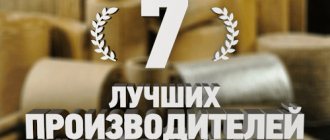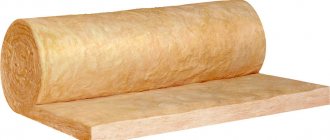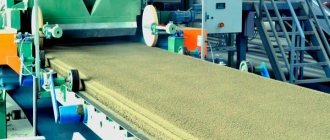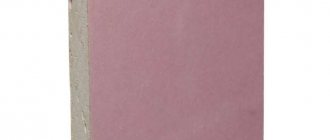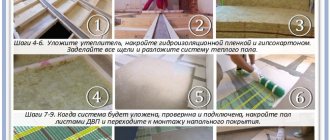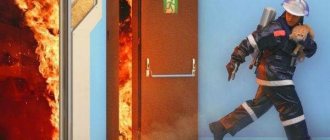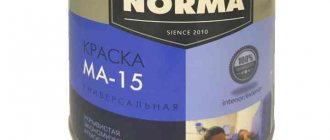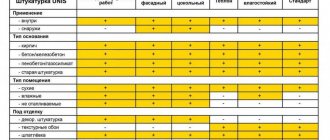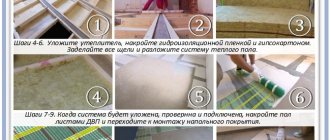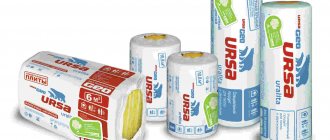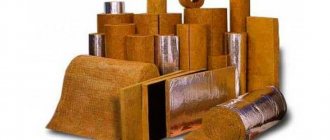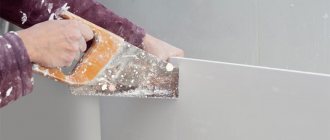What is mineral wool?
The definition of mineral wool is enshrined in GOST 31913-2011. According to him, mineral wool is a class of fibrous materials that are obtained from metal slag and molten rocks.
In fact, the concept of mineral wool refers to not one material, but four:
- glass fiber;
- slag;
- stone wool;
- basalt wool.
All four types have a similar mineral wool composition, but differ in the length and thickness of the fiber. Differences in structure determine the properties of the material. You need to understand what kind of mineral wool you need, because the scope of application depends on its basic parameters; different types of mineral wool have different thermal conductivity, moisture resistance, resistance to mechanical loads, and so on.
Mineral wool insulation was used back in Soviet times as a reliable, high-quality and safe insulation material.
Composition of mineral wool (What is mineral wool made of):
Next, we will dwell in more detail on the question: what is mineral wool made of, because mineral wool from different manufacturers can differ in both density and composition:
- The basis of mineral wool is made up of various rocks. Gabbro-basalt and carbonate rocks are a by-product of metal production. They are used as raw materials for the production of glass wool fibers. Rocks make up 90% of mineral wool. The remaining 10% are various additives.
- Various binders are used to tightly bind the fibers. For these purposes, phenol-based resins and bentonite clay are used.
- The material is covered with a thin layer of paper on top. Usually it is kraft paper with polyethylene or aluminum.
We have listed the main components of mineral wool (about 99% of all mineral wool products consist of them). To find out in more detail what type of mineral wool is in front of you: its composition is indicated on the packaging.
Ventilated facade
A very popular type of exterior decoration that can be used in any season of the year. The requirements for air temperature are as strict as in the “wet” facade technology, where gluing insulation and plastering work can only be carried out at +5...+25°C. The only restriction is that there must be no rain or thick fog. Siding, porcelain stoneware, fiber cement panels, and cassettes are used as finishing.
The installation of an insulated canopy system includes:
- installation of a supporting frame;
- laying a thermal insulation layer;
- external cladding.
The wall must be strong, clean and dry. If the old plaster is strong, you can leave it. Ventilated façade slabs must be designed for vertical installation so as not to deform under their own weight.
At the first stage, marking and installation of brackets for the supporting frame is carried out. They are attached to the wall with 1 or 2 anchors. The minimum distance from the corners is 100 mm; anchoring into a masonry joint is not allowed.
To support the bottom row, a base profile is used, which is mounted as in the description for a “wet” facade. Mineral wool is installed in a checkerboard pattern starting from the bottom. Only mechanical fasteners are used without gluing. First, the slabs are hung through the slots on the brackets, then fixed to the wall using dowels. All joints must be tight; gaps and cracks are not allowed. A vapor-permeable membrane is mounted on the surface of the insulation. The material is rolled out vertically or horizontally and attached to the wall with disc-shaped dowels through thermal insulation. The minimum overlap of the canvases is 100-150 mm. In places of overlap, dowels are also installed with a pitch of 600 mm.
Construction of the frame continues. Guides are attached to the brackets using self-tapping screws or rivets. The plane must be carefully adjusted. Then corner elements, ebbs, cuts and frames of openings are installed. The facing panels are fixed to the supporting frame according to the manufacturer's technology. It is necessary to ensure that there is a ventilation gap of at least 40 mm between the finishing and the insulation.
Mineral wool: varieties
Next, we will tell you what kind of mineral wool there is: in total there are four types of wool - glass wool, slag wool, stone and basalt wool. The last two types have excellent characteristics. The use of the first two types can only be justified by a modest project budget.
Glass wool
This is the most common mineral wool insulation. The fiber thickness of this type of wool is 5-15 micrometers, and the length is up to 5 centimeters. Such characteristics make cotton wool strong and elastic. Care must be taken when working with this material. If the fiber is damaged, glass threads can hurt a person. You should also be careful not to inhale damaged fibers, as fiber particles may enter the lungs. For this reason, when working with this type of mineral wool, builders use special clothing - a respirator, goggles, gloves and a special protective suit.
Technical parameters of glass wool:
| Thermal conductivity coefficient | 0,030 — 0,052 |
| Maximum temperature | 500 degrees Celsius |
| Minimum temperature | -60 degrees Celsius |
| Hygroscopicity of the material | low |
Slag
The fiber thickness of this type of wool is 4-12 micrometers and the length is 1.6 centimeters. This material (like glass wool) has a lot of fatal shortcomings that prevent its use as insulation. It has residual acidity. Because of this, such a material will easily interact with various metal surfaces, oxidizing them. This material easily absorbs moisture. Therefore, it cannot be used for cladding rooms, plastic and metal pipes. It is very prickly, which causes a lot of inconvenience during installation.
Technical parameters of slag:
| Thermal conductivity coefficient | 0,460 — 0,480 |
| Maximum temperature | 300 degrees Celsius |
| Minimum temperature | -50 degrees Celsius |
| Hygroscopicity of the material | high |
Stone wool
What is this type of mineral wool made of: gabbro and diabase, the fiber thickness of this type of wool is 5-12 micrometers, and the length is 1.6 centimeters. This material in its properties resembles slag wool. However, this material does not prick, which will be a big plus during installation. Stone wool does not absorb water well. Therefore, it can be used for heating cladding of premises.
Technical parameters of Stone wool:
| Thermal conductivity coefficient | 0,048 — 0,077 |
| Maximum temperature | 600 degrees Celsius |
| Minimum temperature | -45 degrees Celsius |
| Hygroscopicity of the material | low |
Basalt wool
This type of material is also made from gabbro and diabase. Does not contain blast furnace slag and various additional substances - dolomite, limestone and others. Basalt wool is usually wound into rolls. Mineral wool insulation does not deteriorate during winding. Due to its properties, the material can be used as insulation. This material is very difficult to set on fire. If you bring it to the fire, the fibers will only melt, but the material itself will not burn.
Technical parameters of Basalt wool:
| Thermal conductivity coefficient | 0,035 — 0,042 |
| Maximum temperature | 1000 degrees Celsius |
| Minimum temperature | -190 degrees Celsius |
| Hygroscopicity of the material | very low |
"Wet" facade
This technology involves plastering walls over insulation. The work is carried out in several stages:
- Surface preparation.
- Padding.
- Installation of a plinth profile or temporary support.
- Gluing insulation, mechanical fastening.
- Mesh reinforcement.
- Plastering.
Preparation
The walls are cleaned and leveled. Gutters, sills, air conditioners and other protruding elements are first removed. If mold and moss are present, the surface is treated with antiseptics. Metal parts that cannot be removed are painted with waterproof anti-corrosion compounds.
The base is primed in 2 passes. Using cords or fishing lines, the plane of the facade is set.
Support device
The next step is to install the plinth profile or auxiliary support rail. The profile is fastened with dowels in increments of 30 cm strictly horizontally. The line is marked along the top of the base with a level or laser level. Between adjacent elements you need to leave a compensation gap of 2-3 mm and connect them with a plastic clip.
Overlapping profiles is not allowed. In the corners they are joined by cutting the inner part, the rib should remain intact. If temporary support was used, it is removed after doweling the slabs.
Bonding insulation
The adhesive composition is applied to the slab using the contour-beacon or continuous method. In the first case, the unevenness of the base can reach 30 mm, in the second - no more than 3 mm. First, the surface of the slab is primed with a thin layer of the same adhesive solution.
The adhesive is distributed over the insulation in such a way that after pressing, the adhesive contact area is at least 85% for continuous application and 40% for contour-beacon application. Air bubbles should not be left under the slab, so a small gap is made in the glue strip, which should close during the gluing process.
Plates with applied glue are installed in the direction from bottom to top. Exposed glue is immediately removed. In the corners, the insulation is joined by gearing, that is, the end of each row is alternately pushed onto the underlying one.
Recommendation diagram for applying glue to slabs. Elements must be installed with bandaged seams. With two-layer insulation, the seams should not coincide either vertically or horizontally. The position of each plate is controlled by a level in 3 planes. If there are large inclusions in the mineral wool, they are removed. The sinks are filled with thermal insulation material and rubbed down with sandpaper.
All gaps are sealed with wedge-shaped strips of mineral wool or polyurethane foam. Glue cannot be used due to its relatively high thermal conductivity. The seams must be located at a distance of at least 100 mm from the corner or slope.
Doweling
Mechanical fastening of the boards can begin 24 hours after gluing. The holes are drilled to a depth of 10-15 mm greater than the anchorage length. Plastic dowels are pressed into the holes by hand. Their surface should not protrude beyond the boundaries of the insulation.
The spacer core is screwed or driven in, and the dowel is puttied with an adhesive solution. Fastener consumption - 6-10 pcs per 1 sq.m. Typically, dowels are placed in the corners and in the center of the slab, but in places of increased wind loads (in the corners of the building and at a distance of 1.5 m from them), doweling is done more often.
Protective reinforcement
For its construction, a façade alkali-resistant mesh is used, which is attached directly to the slabs. The adhesive composition is pre-applied, the mesh is carefully immersed, and excess glue is removed.
Layer thickness - 3 mm, on door and window slopes - up to 5 mm. The canvases are overlapped with an overlap of at least 100 mm. The armored meshes are joined without overlap.
Corners, slopes and niches are reinforced with special profiles:
- glue is applied to both parts of the corner across the width of the profile and mesh outlets;
- the reinforcing element is pressed into the adhesive mass;
- Excess composition is removed with a smooth grater.
Internal corners are strengthened in the same way. The slopes and tops of the corners are reinforced with “kerchiefs” - sections of the mesh located at an angle.
The entire plane of the insulation is evenly covered with a reinforcing layer; the mesh under it should not show through. After drying, the surface is sanded with sandpaper.
Finishing
After 48-72 hours, the wall is covered with decorative plaster based on silicone, acrylic or mineral. The surface is covered with a solution using a trowel to a thickness equal to the grain size of the aggregate. The invoice is formed at will.
After 7 days the walls are ready for painting. Facade paint is applied manually or with a spray gun. The frequency of processing is at least 2 times. All gaps between the insulation and the house structures are filled with sealing cord and sealed with sealant.
Mineral wool: types
Mineral wool is usually sold in the form of solid slabs and mats. The use of mineral wool is for lining walls, ceilings and roofs. Mineral wool allows you to work with non-standard surfaces. Types of wool for insulation differ in density; in accordance with this difference, several brands are distinguished. There is light grade mineral wool, the density of which is up to 75 kilograms, but its scope is small.
Mineral wool grade P-75
Main characteristics:
- Material density - 75 kg per cubic meter. m.
- This soft mineral wool is used to insulate horizontal surfaces with light loads. An example of this type of surface is attics.
- This material is often wrapped around district heating, gas and oil pipes to retain heat.
Mineral wool grade P-125
Main characteristics:
- Material density - 125 kg per cubic meter. m.
- Used for insulation of ceilings, floors, interior walls and partitions.
- The material has good sound insulation.
Mineral wool brand PZh-175
Main characteristics:
- Material density - 175 kg per cubic meter. m.
- The material is very dense and has increased rigidity.
- Used for thermal insulation of reinforced concrete and metal walls and ceilings.
Mineral wool brand PPZh-200
Main characteristics:
- Material density - 200 kg per cubic meter. m.
- The material is very dense and has increased rigidity.
- Thanks to special additives it has high fire resistance.
- This construction mineral wool is usually used for thermal insulation of reinforced concrete and metal walls and ceilings.
Glass wool
It is thin (5-15 microns) fibers 1.5-5 cm long, giving elasticity and strength to the material. However, these thin threads of glass can injure the skin of the hands, face, and eyes.
If glass wool is inhaled, the fibers can even injure the lungs. When working with it, it is necessary to use skin, eye and respiratory protection.
The thermal conductivity is about 0.03-0.05 watts per meter per kelvin, the operating temperature range is from -60 to +450 degrees.
What are the main advantages of mineral wool?
This material is respected by ordinary people and experienced builders. And this is no coincidence:
- High fire resistance. In the production of some types of wool, only non-flammable silicate rock melts are used. This provides the material with a high degree of fire resistance. This type of wool does not burn under the influence of high temperatures, and also does not deform. For this reason, mineral wool is used to line rooms where various flammable substances are stored.
- Chemical resistance. Cotton wool does not react well with various chemicals, which makes it possible to use it for lining laboratories, various workshops, and school chemistry classes.
- Resistance to biological irritants. Neither fungi nor various harmful insects and rodents like mineral wool.
- Minor shrinkage. Many materials shrink over time, losing their original volume. This is especially critical for various joint structures, when reducing the size of one of the blocks can lead to a violation of the tightness of the room. Mineral wool does not have this drawback.
- Extremely low hygroscopicity of some varieties of mineral wool. Hard mineral wool absorbs up to 0.5% of liquid. For this reason, the material does not accumulate water.
- High vapor permeability. Cotton wool allows various water vapors to pass through well. This allows you to quickly remove unpleasant odors from the room. Condensation will not settle on such cotton wool.
- High sound insulation properties. This type of wool can be used to sheathe rooms not only for the purpose of insulation, but also to protect the room from extraneous noise.
- Environmental friendliness. The material is safe for humans and does not cause any allergic reactions.
- Easy to install. Mineral wool was made specifically to facilitate the insulation of rooms. Even an amateur builder can install this material.
- Durability. The service life is about 70 years, so you will not have to change the coating several years after installation.
What are the main disadvantages of mineral wool?
However, not everything is so smooth. Mineral wool has the following disadvantages:
- If the fibers are damaged, glass wool fragments can hurt a person. Often the damaged fibers are very small. Inhalation of damaged fibers may cause damage to the lungs and airways. This drawback can be solved very simply - buy a protective suit, gloves, goggles and a respirator.
- Mineral wool often contains formaldehyde resin. Under prolonged exposure to high temperatures, it can oxidize to phenol, which is poisonous. Therefore, when installing in not very safe conditions, experienced builders recommend wearing protective clothing and a gas mask.
Also remember that types of mineral wool, such as stone and basalt, do not have these disadvantages.
Is mineral wool dangerous for health?
This is what phenol-formaldehyde resin looks like when frozen
Many have heard the common myth that mineral wool is harmful to health due to the phenol-formaldehyde resin it contains. In large quantities, this substance becomes carcinogenic. On this basis, many studies and risk assessments for humans have been carried out.
As a result, the following conclusions were made:
- The resin content in the insulation is 4 times less than the maximum permissible norm
- After heat treatment, the resins acquire a solid form. They do not evaporate into the air, which means they are not dangerous
- All patented mineral wool brands have test certificates
- People encounter phenol-formaldehyde compounds every day. For example, a billiard ball is made entirely of this resin. It is added to the chipboard from which furniture is made, to carpets, and plastic dishes.
Buy insulation only from trusted suppliers who can provide test reports and hygiene certificates.
Mineral wool: scope
Mineral wool is used as a building material. It is also used to insulate walls, pipes and various structures. Sometimes mineral wool is used to create sound insulation, but only basal wool has good noise-reducing properties.
Construction materials: mineral wool
In construction, mineral wool is used mainly as insulation. With its help, they create a special wall covering that does not let cold air into the room, but retains warm air. Usually walls are sheathed from the inside, but sometimes some types of cotton wool are also used for sheathing walls on the outside. Cotton wool is also used to insulate gas-carrying pipes on the streets and in the entrances of houses.
Mineral wool insulation: slabs
There are different types of mineral wool for insulation, but you should give preference to mineral wool slabs. And that's why:
- The slabs are easy and convenient to cut.
- The slabs are easy to transport and do not require special care.
- The slabs can be laid on an uneven surface to hide the imperfections of load-bearing walls.
Multilayer masonry with effective insulation
The design includes a load-bearing layer, thermal insulation and cladding. To connect the inner and outer layers, fiberglass connections with special limiters are used. They are not subject to corrosion, and due to low thermal conductivity it is possible to avoid freezing at the attachment points.
Basalt wool walls cannot be laid without a ventilation gap. Limiters do not allow the insulation to come into contact with the outer cladding, thereby maintaining its position in space and ensuring air circulation inside the structure. At the joints of the plates, gaskets made of polymers, for example, penoplex, are additionally installed.
Multilayer masonry is much lighter and warmer than solid masonry. The cladding is made of brick, which is much more durable than plaster and finishing panels. During the entire life of the building, repairs to decorative finishes are not required, of course, subject to strict adherence to technology.
How to safely install mineral wool?
When installing mineral wool, you must follow these rules:
- Wear a protective suit, respirator, special glasses and gloves.
- When working with the material, cover it with polyvinyl chloride film, which allows steam to pass through.
- Give preference to materials from a reliable manufacturer.
- To create mineral wool insulation, slabs can help you.
- Remember that formaldehyde resin does not oxidize at room temperature.
- If you will be working at high ambient temperatures, give preference to basalt wool, which does not release phenol during oxidation.
Characteristics
Mineral wool according to GOST 4640-2011 must have the following physical and chemical parameters:
- thread diameter - 3-8 microns;
- organic inclusions - no more than 2%;
- non-fibrous components - 8-16%;
- compressibility - up to 25%;
- thermal conductivity - 0.036-0.060 W/mK depending on temperature;
- acidity module - 1.4-2.0;
- water resistance - up to 4 pH;
- water absorption - from 6 to 30%;
- humidity - no more than 1%;
- specific activity of radionuclides - up to 360 Bq/kg.
The standard length of the slabs is 500-2000 mm, width 400-1000 mm, thickness 20-200 mm.
How to choose good mineral wool?
When choosing mineral wool, use the following tips from experienced builders:
- Give preference to European cotton wool. The reason for this choice is simple - in the European Union there is a fairly strict certification system, under which mineral wool manufacturers cannot release their product to the market without preliminary tests. Yes, German quality is not a myth, but only a simple consequence of pragmatic European laws. Examples of European wool manufacturers are URSA, Rockwool, PAROC, ISOVER and others.
- If you need mineral wool, the slabs will help you. You can buy cotton wool in rolls, but it is more difficult to transport.
- It doesn't really matter when the mineral wool was made, as it usually has a shelf life of at least 50 years.
- The price of wool directly depends on its density. The explanation is simple - it is much more difficult to make a denser material than a less dense one, which greatly affects the final cost of the product.
- Give your preference to stone and basalt wool. Glass wool and slag wool, although they are very cheap, have many disadvantages. This is both low thermal insulation and low noise insulation. During installation, many problems may arise due to damage to the fibers of the material. If a fragment of fiber gets on the skin, it will hurt and itch.
- If mineral wool is too expensive, using used one will solve your problem.
- The direction of the fibers is of great importance. It is not recommended to use material with horizontal fibers (and such material is quite rare). The vertical arrangement of fibers improves the heat and sound insulation characteristics of the product. If the fibers in the wool are randomly located, then it will withstand high loads.
- Be sure to check the box with the material for printing confirming GOST. Also find out from the seller what the mineral wool you want to buy is made from.
- Don't trust sellers. Suppose you need a slab 5 centimeters thick. Go to the seller and tell him that you need a 5-centimeter thick slab. When the seller brings the stove, ask to open the box to personally verify that the stove matches your order. If the seller tries to dissuade you, don't listen to him, you know better.
- To find out what mineral wool is made from, pay attention to the composition indicated on the packaging.
The best manufacturers
v
The comfort and safety of people in the room depends on the use of proper insulation. Leaders in the production of mineral wool strive to achieve a product combination of construction advantages, environmental friendliness of the product while maintaining an acceptable price for the product.
According to consumer reviews, the ranking of the best brands is as follows.
Rockwool
Danish company with factories in Russia. They produce stone wool with enhanced properties:
- fire safety - fibers can withstand temperatures up to 1000°C (standard 600°C);
- sound absorption – products are chosen for acoustic comfort;
- environmental friendliness;
- durability - maintains quality indicators during operation;
- thermal insulation.
Read more about Rockwool.
Paroc
In the production of basalt wool, the company identifies priority quality areas, which are:
- saving energy, including heat;
- environmental friendliness;
- soundproofing;
- fire safety.
The manufacturer does not allow counterfeits and realizes the advantages of stone wool in full.
The downside is the high price.
Facade insulation
Isover
The manufacturer produces two types of insulation: stone wool and fiberglass wool. This suits builders who need different materials according to the conditions of the objects being built. The best side of the product is the reduction in the “prickliness” of products while maintaining high characteristics of the main indicators.
The price-quality ratio of this company is one of the best on the mineral wool market.
Izover insulation
Knauf
The products are represented by basalt mineral wool and fiberglass-based insulation.
An important factor was the specialized purpose of the products, reflected in the names:
- Acoustic partition;
- HEATWALL;
- WARM roofing, etc.
The environmentally friendly material is intended for construction work on the construction of residential buildings. The high price is the only drawback.
IZOVOL
The low price of basalt products used for insulation of walls, facades, and roofs is attractive. Quality indicators meet standards. The disadvantage is a slight shedding of the material during work. A particularly popular area is finishing attics and pitched roofs with Izovol mineral wool. Mineral wool is fire resistant, environmentally friendly, and has good thermal insulation properties.
What are the recommendations for installing mineral slabs?
When installing mineral wool, use the following tips from experienced builders:
- To insulate a simple flat roof, lay mineral slabs in two layers. The fact is that in winter the roof freezes the hardest and will require additional protection.
- For soundproofing coating of wooden structures, use cotton wool with granules.
- To create “wet” type heat-insulating insulation, use laminated mineral wool.
- If you are making a roof with water drainage, buy a slab with a variable cross-section.
- When marking slabs, use a pencil. This will make cutting and measuring much easier.
Installation methods
Mineral wool slabs are installed in two ways: dry and wet . The first involves laying slabs in the gap between the wall and the sheathing. For this, a wooden or metal frame is created. The insulation is laid in the spaces between the profiles. The wet method is gluing slabs onto the wall surface, followed by applying a primer and mesh reinforcement. Installation of mineral wool cylinders is carried out using self-adhesive tape or thin wire.
How to transport mineral wool correctly?
Rolls are formed from the mats, and the slabs are collected in packs of several pieces (their number in one package depends on the thickness of the material). The average pack of slabs has an area of 0.35 square meters, and the weight of such a package ranges from 10 to 70 kilograms. More accurate data is usually stored in the seller's catalogue.
Use a hacksaw to cut mineral wool into fragments. Before cutting, mark the material with a pencil. It is advisable to cut cotton wool in rolls before wrapping. It is advisable to cut the slabs separately.
To transport glass wool and slag wool, use closed vehicles so that various precipitation does not wet the material. Store this material in a dry place. Stone and basalt wools do not need such careful care because they do not absorb moisture well. During transportation, cotton wool decreases slightly in volume because it is in a compressed state. Mineral wool is quite easy to damage, so walking on it is not recommended. Place the wool in the slabs one on top of the other, but so that the total height does not exceed two meters.
Conclusions about Mineral Wool as insulation.
Mineral wool is suitable for insulating rooms. Mineral wool is a special material that complies with GOST 31913-2011. Mineral wool is made from rock melts with the addition of slag. There are four main types of materials - glass wool, slag wool, stone wool and basalt wool. The first two types are cheap, but get wet easily and have poor soundproofing properties. The last two types retain heat well and do not allow noise to pass through.
Mineral wool: application.
When installing mineral wool, it is advisable to wear a protective suit, goggles, gloves and a gas mask. The explanation is that damaged fibers can easily injure. Also, do not inhale dust particles containing fragments of mineral fibers into your lungs. One of the main parameters of slabs is its density. A very dense slab will withstand heavy loads, but it will cost you a pretty penny. And vice versa - if the density of the slab is low, it will not cost you much. Light mineral wool is practically not used because it cannot withstand heavy loads. The use of mineral wool depends on the task you face.
The use of mineral wool has both advantages and disadvantages. The advantages of all types of slabs include ease of installation, resistance to chemical and biological influences, environmental friendliness and good vapor permeability. Fire resistance and good heat and sound insulation properties are also true for stone and basalt wool. The disadvantages of the boards include the presence of prickly fibers and formaldehyde resins in their composition. The former can hurt a person painfully, and formaldehyde resins can oxidize to the toxic substance phenol. However, stone and basalt varieties are practically free of these disadvantages.
When choosing cotton wool, give preference to European manufacturers, since the European Union has a serious certification system. Don't skimp on cotton wool - buy reliable and expensive cotton wool. When choosing, also pay attention to the direction of the mineral fibers. If you need a dense material, choose a slab with a random arrangement of fibers; if you need a material with high heat and sound insulating properties, give preference to a vertical arrangement of fibers. Before purchasing, be sure to check the product for the presence of a seal confirming GOST. When purchasing, check the technical parameters of the material manually and do not trust sellers.
Cotton wool is sold in two forms - in the form of slabs and in the form of mats. The mats are wound into rolls; The slabs are placed in special boxes. If you bought glass wool or slag wool, transport it in closed cars to avoid accidental precipitation getting on it. Before cutting, mark with a pencil directly on the surface of the material. You need to cut the material using a hacksaw.
Selection rules
In order to competently carry out the insulation procedure, you need to do one important thing - choose the right material for the upcoming work. If the owner plans to use mineral wool insulation, the characteristics should be studied in advance. It is best to choose slabs with maximum density. It is necessary to lay a layer of finishing on top or apply plaster over the insulating layer. For facade walls, it is best to use a heat insulator that has minimal water absorption rates.
When carrying out work on insulating premises, you can use not only slabs, but also mats. They are a roll material and are an ideal choice in multi-layer structures that are decorated with rigid cladding material.
When selecting the parameters of a fiber solution for thermal insulation of indoor walls, it is necessary to pay attention to the material from which they are made. High-density insulation is not suitable for wooden walls. Such surfaces must “breathe”. When choosing a heat insulator, you should be guided by the rule: the thinner the wall thickness and the higher the thermal conductivity, the thicker the layer of material should be.
This heat insulator is the best choice when it is necessary to carry out high-quality insulation. The performance properties of mineral wool attract many owners. Its scope of application is diverse. It can be used during construction work at any site. The quality of the insulation procedure is ensured only if the work is carried out in accordance with existing technology. In this case, heat loss is reduced and a comfortable microclimate is provided in the home.
